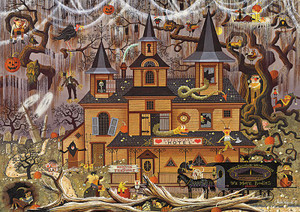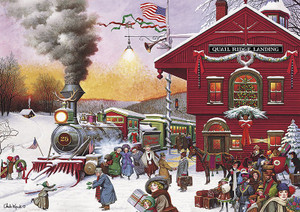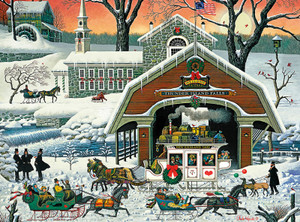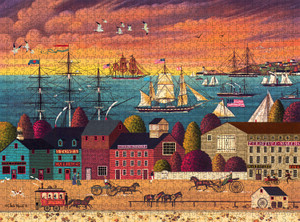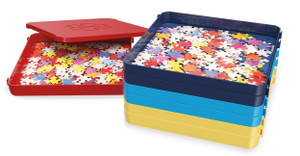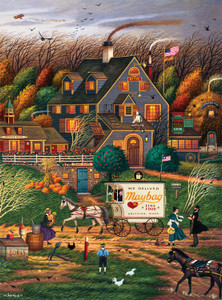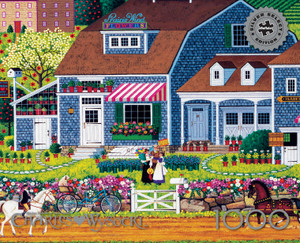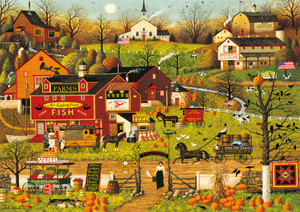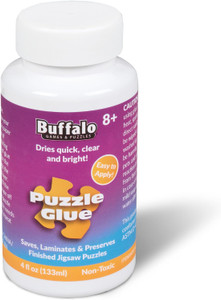Posted by Buffalo Games on Apr 22nd 2022
The Fastest Way to Solve a 500-Piece Puzzle
Your average 500-piece puzzle isn’t likely to be quite as challenging as one that has 1,000, 2,000, or more, but that doesn’t mean it won’t take up a fair chunk of your day — or even a couple of days — depending on the complexity of the image.
If you’re just looking to while away a lazy Sunday afternoon without waking Monday morning to find your coffee table covered with a half-finished puzzle, you’ll need to create a strategy for quick assembly.
Luckily, there are several things you can do to prepare that will help to speed the completion process and spare yourself a lot of frustration along the way. If you want to assemble 500 pieces in record time, here are the simple tricks that will make it go much faster.
Look for Image Variation
If you’re looking for a quick fix for your favorite hobby when you’re browsing the puzzles store, one of the best things you can do is look for an image with a lot of variation, in terms of color, pattern, texture, and so on.
Some puzzles have many colors, but the colors are flat. This is especially common with cartoon images.
There’s nothing wrong with this, but a greater range of gradation — even if there are fewer colors present — can make it easier to figure out where pieces go. More realistic and lifelike images that feature a significant variety of colors, patterns, and textures that can provide more opportunities for sorting and ultimately, faster assembly.
Prep Your Workspace
You might think any work surface is basically as good as the next when it comes to puzzling, as long as it’s flat. If you’re doing simple 100-300 piece puzzles, you may be right. However, when you start getting into bigger projects — like 500 pieces and up — that are going to take more time, you’ll start to understand why some surfaces are better than others.
A Smooth Surface
A smooth, flat surface is always going to be your best bet, so forego the rough-hewn stone coffee table in favor of your polished dining table or even a card table where your puzzle will lie flat as you progress and you’ll have no trouble sliding pieces around. Another option is a puzzle mat specifically designed for this activity.
Puzzle Mat
There are a couple of reasons to use a mat if you subscribe and puzzle frequently. First, this tool can provide a good contrasting surface to a light or dark image that will help puzzle pieces to stand out.
In addition, it can be rolled up to keep all of your puzzle pieces in place if you have to take a break or move your puzzle out of the way to reclaim your dining surface, for example.
When you’re assembling complex jigsaw puzzles for adults, you might find the process takes several hours or more, even if you follow top strategies designed for speed. Using the right surface from the get-go will help you achieve your best time.
Get Sorted
The process of sorting 1,000-piece puzzles might naturally be a little more complicated than 500 pieces. However, you’ll find you can employ similar strategies, regardless of size, if you want to cut down on assembly time.
If you’re attempting relatively simple 500-piece puzzles, you might be okay just separating out edges to get started, but you could also move into sorting by color groups that can be attributed to certain zones in the overall image.
If there are several areas of similar color, you can break them down further by specific gradients, patterns, and textures.
In many cases, you’ll find particular pieces that are easily identifiable by notable characteristics like facial features, architectural details, or other markers. These can serve as a starting point to build on.
If you happen to be super organized, you can even go group by group and separate pieces by their configuration (i.e., number of tabs and blanks, orientation, etc.). However, this may be a bit too granular for a 500-piece puzzle, and it could end up wasting more time than it saves.
To keep pieces separated, you might want to set out a series of boxes, bins, or even paper plates, so pieces don’t commingle as you sift through them. Plastic food storage containers from the supermarket work great because they’re cheap, stackable for storage when not in use, and they have lids to ensure that curious kids or pets don’t undo your organization when you step away.
Budget Your Time
Whether you’re doing 500- or 2000-piece puzzles, it’s important to take time for breaks every hour or so. Hit the restroom, grab a snack, or simply walk around the block to stretch and clear your head. This will help you to avoid fatigue and frustration that could actually slow you down over time.
Invite Family and Friends to Help
One of the best things about puzzles is that they make for an ideal group activity. While some games require special skills and others have pages of instructions, you can jump right in with a puzzle by simply dumping the contents of the box on a suitably sized surface.
Barring small children, puzzles are great for almost every age, which means the whole family can get in on the fun. A 500-piece jigsaw puzzle is fairly manageable for nearly any participant. Whether you have a group of two or ten, you can easily finish in a day — and probably much faster.
While 100-piece puzzles won’t occupy a single person for long, much less several, the difficulty of 500 pieces is just enough to make even a decent-sized group feel like they got their money’s worth, so to speak, and give you plenty of time for fun socialization along the way. Best of all, you’ll finish fast enough that no one is likely to lose interest.
Whether you’re looking for a chill afternoon activity during your upcoming family vacay or you want a unique ice breaker when commingling with friends and coworkers at a summer BBQ or dinner party, jigsaw puzzles offer an ideal means of creating a team atmosphere that gets everyone in sync.





